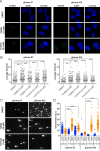Glioblastoma and glioblastoma stem cells are dependent on functional MTH1
- PMID: 29156675
- PMCID: PMC5689565
- DOI: 10.18632/oncotarget.19404
Glioblastoma and glioblastoma stem cells are dependent on functional MTH1
Erratum in
-
Correction: Glioblastoma and glioblastoma stem cells are dependent on functional MTH1.Oncotarget. 2020 Feb 25;11(8):827. doi: 10.18632/oncotarget.27484. eCollection 2020 Feb 25. Oncotarget. 2020. PMID: 32166004 Free PMC article.
Abstract
Glioblastoma multiforme (GBM) is an aggressive form of brain cancer with poor prognosis. Cancer cells are characterized by a specific redox environment that adjusts metabolism to its specific needs and allows the tumor to grow and metastasize. As a consequence, cancer cells and especially GBM cells suffer from elevated oxidative pressure which requires antioxidant-defense and other sanitation enzymes to be upregulated. MTH1, which degrades oxidized nucleotides, is one of these defense enzymes and represents a promising cancer target. We found MTH1 expression levels elevated and correlated with GBM aggressiveness and discovered that siRNA knock-down or inhibition of MTH1 with small molecules efficiently reduced viability of patient-derived GBM cultures. The effect of MTH1 loss on GBM viability was likely mediated through incorporation of oxidized nucleotides and subsequent DNA damage. We revealed that MTH1 inhibition targets GBM independent of aggressiveness as well as potently kills putative GBM stem cells in vitro. We used an orthotopic zebrafish model to confirm our results in vivo and light-sheet microscopy to follow the effect of MTH1 inhibition in GBM in real time. In conclusion, MTH1 represents a promising target for GBM therapy and MTH1 inhibitors may also be effective in patients that suffer from recurring disease.
Keywords: DNA damage; MTH1; Nudt1; cancer stem cells; glioblastoma multiforme.
Conflict of interest statement
CONFLICTS OF INTEREST MTH1 inhibitors are developed in the laboratory of TH for the treatment of cancer.
Figures






Similar articles
-
Mechanisms of MTH1 inhibition-induced DNA strand breaks: The slippery slope from the oxidized nucleotide pool to genotoxic damage.DNA Repair (Amst). 2019 May;77:18-26. doi: 10.1016/j.dnarep.2019.03.001. Epub 2019 Mar 2. DNA Repair (Amst). 2019. PMID: 30852368 Free PMC article. Review.
-
Birth of MTH1 as a therapeutic target for glioblastoma: MTH1 is indispensable for gliomatumorigenesis.Am J Transl Res. 2016 Jun 15;8(6):2803-11. eCollection 2016. Am J Transl Res. 2016. PMID: 27398163 Free PMC article.
-
Hypoxic Signaling and the Cellular Redox Tumor Environment Determine Sensitivity to MTH1 Inhibition.Cancer Res. 2016 Apr 15;76(8):2366-75. doi: 10.1158/0008-5472.CAN-15-2380. Epub 2016 Feb 9. Cancer Res. 2016. PMID: 26862114
-
MTH1 deficiency selectively increases non-cytotoxic oxidative DNA damage in lung cancer cells: more bad news than good?BMC Cancer. 2018 Apr 16;18(1):423. doi: 10.1186/s12885-018-4332-7. BMC Cancer. 2018. PMID: 29661172 Free PMC article.
-
MTH1 as a Chemotherapeutic Target: The Elephant in the Room.Cancers (Basel). 2017 May 8;9(5):47. doi: 10.3390/cancers9050047. Cancers (Basel). 2017. PMID: 28481306 Free PMC article. Review.
Cited by
-
Mechanisms of MTH1 inhibition-induced DNA strand breaks: The slippery slope from the oxidized nucleotide pool to genotoxic damage.DNA Repair (Amst). 2019 May;77:18-26. doi: 10.1016/j.dnarep.2019.03.001. Epub 2019 Mar 2. DNA Repair (Amst). 2019. PMID: 30852368 Free PMC article. Review.
-
Modeling human brain tumors in flies, worms, and zebrafish: From proof of principle to novel therapeutic targets.Neuro Oncol. 2021 May 5;23(5):718-731. doi: 10.1093/neuonc/noaa306. Neuro Oncol. 2021. PMID: 33378446 Free PMC article. Review.
-
MTH1 Inhibitor TH1579 Induces Oxidative DNA Damage and Mitotic Arrest in Acute Myeloid Leukemia.Cancer Res. 2021 Nov 15;81(22):5733-5744. doi: 10.1158/0008-5472.CAN-21-0061. Epub 2021 Sep 30. Cancer Res. 2021. PMID: 34593524 Free PMC article.
-
HIF2α promotes tumour growth in clear cell renal cell carcinoma by increasing the expression of NUDT1 to reduce oxidative stress.Clin Transl Med. 2021 Nov;11(11):e592. doi: 10.1002/ctm2.592. Clin Transl Med. 2021. PMID: 34841698 Free PMC article.
-
Effects of postoperative radiotherapy and docetaxel and PD-1 inhibitors on the survival and safety of glioblastoma patients: a systematic review and meta-analysis.Ann Transl Med. 2022 Dec;10(24):1326. doi: 10.21037/atm-22-2670. Ann Transl Med. 2022. PMID: 36660707 Free PMC article.
References
-
- Curran WJ, Scott CB, Horton J, Nelson JS, Weinstein AS, Fischbach AJ, Chang CH, Rotman M, Asbell SO, Krisch RE. Recursive partitioning analysis of prognostic factors in three Radiation Therapy Oncology Group malignant glioma trials. J Natl Cancer Inst. 1993;85:704–10. - PubMed
LinkOut - more resources
Full Text Sources
Other Literature Sources
Molecular Biology Databases
Research Materials

